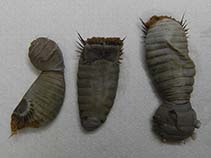Sternaspis scutata Ranzani, 1817
Scutate stermaspid worm| Native range | All suitable habitat | Point map | Year 2050 |

|
| This map was computer-generated and has not yet been reviewed. |
| Sternaspis scutata AquaMaps Data sources: GBIF OBIS |
Classification / Names Common names | Synonyms | CoL | ITIS | WoRMS
Polychaeta | Canalipalpata | Sternaspidae
Environment: milieu / climate zone / depth range / distribution range Ecology
Benthic; brackish; depth range 6 - 181 m (Ref. 112705). Tropical
Distribution Countries | FAO areas | Ecosystems | Occurrences | Introductions
Arctic, Indo-Pacific, Atlantic, Adriatic, Mediterranean and Antarctic Atlantic: Central America to northern Brazil and Canadian Arctic Archipelago. Tropical to polar.
Length at first maturity / Size / Weight / Age
Maturity: Lm ? range ? - ? cm
Life cycle and mating behavior Maturity | Reproduction | Spawning | Eggs | Fecundity | Larvae
Main reference
References | Coordinator | Collaborators
Salazar-Vallejo, S.I. and M.H. Londoño-Mesa 2004 Lista de especies y bibliografía de poliquetos (Polychaeta) del Pacífico Oriental Tropical. Anales del Instituto de Biología, Universidad Nacional Autónoma de México, Serie Zoología 75(1):9-97. (Ref. 8159)
IUCN Red List Status
(Ref. 130435: Version 2025-1)
CITES status (Ref. 108899)
CMS (Ref. 116361)
Threat to humans
Human uses
| FishSource |
Tools
More information
Max. ages / sizes
Length-weight rel.
Length-length rel.
Length-frequencies
Mass conversion
Abundance
Internet sources
BHL | BOLD Systems | CISTI | DiscoverLife | FAO(Publication : search) | Fishipedia | GenBank (genome, nucleotide) | GloBI | Gomexsi | Google Books | Google Scholar | Google | PubMed | Tree of Life | Wikipedia (Go, Search) | Zoological Record



